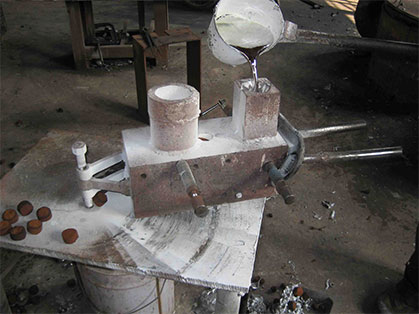Cast aluminum alloy has many advantages that other castings can't compare, such as beauty, light weight, corrosion resistance and so on, which makes it widely favored by users, especially since the automobile lightweight, cast aluminum alloy castings have been widely used in the automobile industry.
The density of cast aluminum alloy is smaller than that of cast iron and cast steel, but the specific strength is higher. Therefore, aluminum alloy castings can reduce the weight of the structure under the same load. Therefore, aluminum alloy castings are widely used in the aviation industry, power machinery, and transportation machinery manufacturing.
Aluminum alloy has good surface luster and good corrosion resistance in the atmosphere and fresh water, so it has a wide range of applications in the manufacture of civil utensils. Pure aluminum has good corrosion resistance in oxidizing acid medium such as nitric acid and acetic acid, so aluminum casting has certain application in chemical industry.
Pure aluminum and aluminum alloy have good thermal conductivity. The heat exchange device used in chemical production and the parts required to have good thermal conductivity in power machinery, such as cylinder head and piston of internal combustion engine, are also suitable for manufacturing with aluminum alloy.
Casting aluminum alloy casting has many advantages, which makes it become the development direction of casting industry and one of the most favored casting products for customers. With the progress of aluminum alloy casting technology in the future, it will show its style on a larger stage.
Defect analysis of aluminum alloy gravity casting
Gravity casting of aluminum alloy is a process which is made of metal casting to obtain aluminum alloy and aluminum alloy gravity casting parts of parts. Gravity casting of aluminum alloy is characterized by fluidity, shrinkage, heat, air tightness, casting stress and air absorption.

Slag is the oxidation slag which is mostly distributed on the upper surface of the casting, and the corner of the mold is not ventilated. The fracture surface is mostly gray white or yellow, which can be found by X-ray fluoroscopy or machining, or by alkali washing, pickling or anodizing
Air hole bubble is a kind of round or ellipse air hole in the wall of three castings, with smooth surface, shiny oxide skin and oil yellow sometimes. The surface porosity and bubbles can be found by sandblasting, and the internal porosity bubbles can be found to be black on the X-ray film by X-ray fluoroscopy or machining.
The shrinkage porosity of aluminum castings generally occurs in the thick part of the root of the flying riser near the inner sprue, the thick and thin joint of the wall and the thin wall with a large plane. The fracture surface is gray in as cast condition, gray white light yellow or gray black in light yellow after heat treatment. The serious filamentous shrinkage on X-ray film can be found by X-ray and fluorescence low power fracture inspection.
There are usually two situations:
1. Casting crack: The development along the grain boundary, often accompanied by segregation, is a kind of crack formed at a higher temperature, which is easy to appear in alloys with larger volume shrinkage and castings with more complex shapes.
2. Heat treatment crack: it is often a transgranular crack due to over burning or overheating of heat treatment. Too much cooling often occurs in alloys with high stress and thermal expansion coefficient. Or other metallurgical defects
The analysis shows that the most common defect in die casting is porosity. Stomatal characteristics. It has a smooth surface and the shape is round or oval. The expression may be on the surface of the casting, or under the skin pinhole, or inside the casting.
